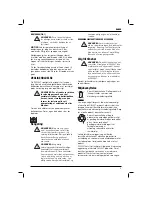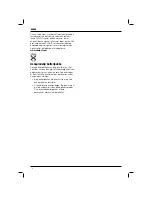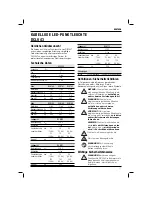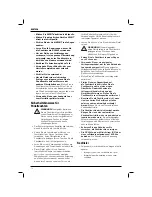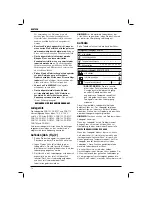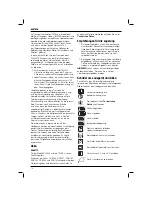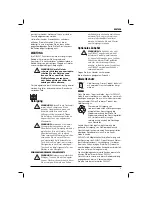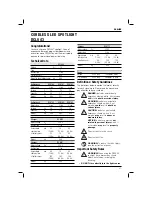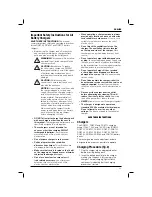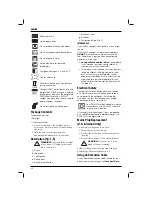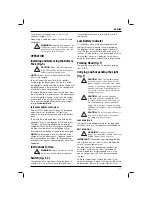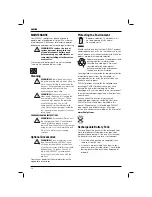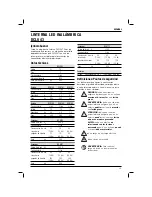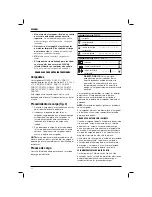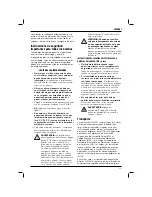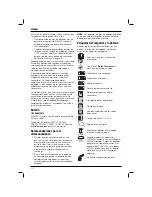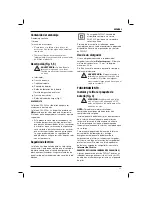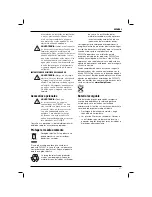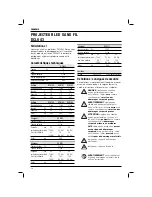
ENGLISH
23
Important Safety Instructions for All
Battery Chargers
SAVE THESE INSTRUCTIONS:
This manual
contains important safety and operating instruc tions
for the DCB105, DCB107 and DCB112 battery
chargers.
• Before using the charger, read all instructions
and cautionary markings on charger, battery
pack and product using the battery pack.
WARNING:
Shock hazard. Do not allow
any liquid to get inside charger. Electric
shock may result.
CAUTION:
Burn hazard. To reduce
the risk of injury, charge only D
E
WALT
rechargeable battery packs. Other types
of batteries may overheat and burst
resulting in personal injury and property
damage.
CAUTION:
Children should be
supervised to ensure that they do not
play with the appliance.
NOTICE:
Under certain conditions, with
the charger plugged in to the power
supply, the exposed charging contacts
inside the charger can be shorted by
foreign material. Foreign materials of
a conductive nature such as, but not
limited to, steel wool, aluminum foil or
any buildup of metallic particles should
be kept away from charger cavities.
Always unplug the charger from the
power supply when there is no battery
pack in the cavity. Unplug charger
before attempting to clean.
• DO NOT attempt to charge the battery pack
with any chargers other than the ones in
this manual.
The charger and battery pack are
specifically designed to work together.
• These chargers are not intended for
any uses other than charging D
E
WALT
rechargeable batteries.
Any other uses
may result in risk of fire, electric shock or
electrocution.
• Do not expose charger to rain or snow.
• Pull by plug rather than cord when
disconnecting charger.
This will reduce risk
of damage to electric plug and cord.
• Make sure that cord is located so that it will
not be stepped on, tripped over or otherwise
subjected to damage or stress
.
• Do not use an extension cord unless it
is absolutely necessary.
Use of improper
extension cord could result in risk of fire,
electric shock or electrocution.
•
When operating a charger outdoors, always
provide a dry location and use an extension
cord suitable for outdoor use.
Use of a cord
suitable for outdoor use reduces the risk of
electric shock.
• Do not block the ventilation slots on the
charger. The ventilation slots are located
on the top and sides of the charger.
Place
the charger in a position away from any heat
source.
• Do not operate charger with damaged cord
or plug.
In case of damaged power supply cord
the supply cord must be replaced immediately
by the manufacturer, its service agent or similar
qualified person to prevent any hazard.
•
Do not operate charger if it has received
a sharp blow, been dropped or otherwise
damaged in any way.
Take it to an authorised
service centre.
• Do not disassemble the charger; take it to
an authorised service centre when service or
repair is required.
Incorrect reassembly may
result in a risk of electric shock, electrocution or
fire.
• Disconnect the charger from the outlet
before attempting any cleaning. This will
reduce the risk of electric shock.
Removing
the battery pack will not reduce this risk.
• NEVER
attempt to connect 2 chargers together.
• The charger is designed to operate on
standard 230 V household electrical power.
Do not attempt to use it on any other
voltage.
This does not apply to the vehicular
charger.
SAVE THESE INSTRUCTIONS
Chargers
The DCB105, DCB107 and DCB112 chargers
accept 10.8V, 14.4V and 18V XR Li-Ion (DCB123,
DCB125, DCB127, DCB140, DCB141, DCB142,
DCB143, DCB144, DCB145, DCB180, DCB181,
DCB182, DCB183, DCB184 and DCB185) battery
packs.
These chargers require no adjustment and are
designed to be as easy as possible to operate.
Charging Procedure (fi g. 2)
1. Plug the charger into an appropriate outlet
before inserting battery pack.
2. Insert the battery pack (d) into the charger,
making sure the pack is fully seated in the
charger. The red (charging) light will blink
continuously indicating that the charging
process has started.
Summary of Contents for XR LI-ION DCL043
Page 1: ...DCL043 ...
Page 3: ...1 Figure 1 Figure 2 d Figure 5 b c a d e f g j i Figure 3 Figure 4 e d h ...
Page 121: ...119 ...
Page 122: ...120 ...
Page 123: ...121 ...

